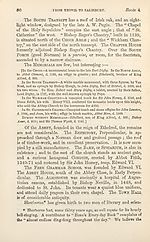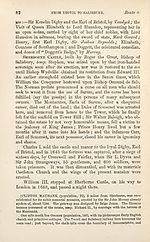Download files
Complete book:
Individual page:
Thumbnail gallery: Grid view | List view

Route 4.
SHERBORNE CASTLE.
81
tific repute -.— Bradley, tlie astronomer-royal, bom 1692; and
JosephTowers, a divine and scholar of great erudition, bom 1737.
Our great English tragedian, the worthy successor of Kean and
Kemble, William Charles Macready (bom 1793), has occupied
Sherborne House since 1851. Of the Sherborne Literary
Institute, he has been an energetic patron.
About half a mile east, on the ridge which overlooks the
town, and belted round with a ring of noble woods, stands
Sherborne Castle (G. D. Wingfield Digby, Esq.), as charming
“ a bit” of Tudor architecture as one could wish to meet with,
when fresh from studies of the brave men and chaste women who
lent such a grace and glory to the Elizabethan age. In its plan
its resembles the letter ]—[, with hexagonal towers at each angle,
and two others on each side of the centre of the principal front.
The centre is ascribed to Sir Walter Raleigh ; the wings to the
Earl of Bristol (after the Restoration). The stone walls have been
coated with gray plaster, which is now streaked with lichens of
various colours. An archway of stone, surmounted by the Digby
crest, forms the entrance into the courtyard. The gardens are
very quaint and pleasant, and present a favourable illustration of
the taste and skill of “ Capability Brown.” A stone seat is
pointed out as that frequented by Raleigh when he indulged in
the “ Virginian weed,” and in the park, which is 5 miles in
circuit, and contains 1170 acres, is shewn a grove planted by the
great adventurer, and another planted by Pope, who was the
guest here of Lord Digby. A large sheet of artificial water,
formed by damming up what was but an inconsiderable stream,
is now considered “ one of the most beautiful and extensive
lakes ” in the west of England. It divides the pleasaunce from
the woods which encircle the ruins of the ancient castle.
Among the works of art. collected here, the most interesting
church bells are still tolled for two hours on the 23d of September to com¬
memorate the death of John, Earl of Bristol, died 1698, and in pursuance
of the directions of his will. The bell-ringers receive bread and cheese,
beer, and a small sum of money. . . . Pack-Monday Fair is held on
the first Monday after the 10th of October. “ Tradition relates that this
fair originated at the termination of the building of the church, when
the people who had been employed about it packed up their tools, and
held a fair, or wake, in the churchyard, blowing cows’ horns in their
rejoicing, which at that time was perhaps the most common music
SHERBORNE CASTLE.
81
tific repute -.— Bradley, tlie astronomer-royal, bom 1692; and
JosephTowers, a divine and scholar of great erudition, bom 1737.
Our great English tragedian, the worthy successor of Kean and
Kemble, William Charles Macready (bom 1793), has occupied
Sherborne House since 1851. Of the Sherborne Literary
Institute, he has been an energetic patron.
About half a mile east, on the ridge which overlooks the
town, and belted round with a ring of noble woods, stands
Sherborne Castle (G. D. Wingfield Digby, Esq.), as charming
“ a bit” of Tudor architecture as one could wish to meet with,
when fresh from studies of the brave men and chaste women who
lent such a grace and glory to the Elizabethan age. In its plan
its resembles the letter ]—[, with hexagonal towers at each angle,
and two others on each side of the centre of the principal front.
The centre is ascribed to Sir Walter Raleigh ; the wings to the
Earl of Bristol (after the Restoration). The stone walls have been
coated with gray plaster, which is now streaked with lichens of
various colours. An archway of stone, surmounted by the Digby
crest, forms the entrance into the courtyard. The gardens are
very quaint and pleasant, and present a favourable illustration of
the taste and skill of “ Capability Brown.” A stone seat is
pointed out as that frequented by Raleigh when he indulged in
the “ Virginian weed,” and in the park, which is 5 miles in
circuit, and contains 1170 acres, is shewn a grove planted by the
great adventurer, and another planted by Pope, who was the
guest here of Lord Digby. A large sheet of artificial water,
formed by damming up what was but an inconsiderable stream,
is now considered “ one of the most beautiful and extensive
lakes ” in the west of England. It divides the pleasaunce from
the woods which encircle the ruins of the ancient castle.
Among the works of art. collected here, the most interesting
church bells are still tolled for two hours on the 23d of September to com¬
memorate the death of John, Earl of Bristol, died 1698, and in pursuance
of the directions of his will. The bell-ringers receive bread and cheese,
beer, and a small sum of money. . . . Pack-Monday Fair is held on
the first Monday after the 10th of October. “ Tradition relates that this
fair originated at the termination of the building of the church, when
the people who had been employed about it packed up their tools, and
held a fair, or wake, in the churchyard, blowing cows’ horns in their
rejoicing, which at that time was perhaps the most common music
Set display mode to:
![]() Universal Viewer |
Universal Viewer | ![]() Mirador |
Large image | Transcription
Mirador |
Large image | Transcription
| Antiquarian books of Scotland > Adventure and adventurers > Black's guide to the counties of Dorset, Devon, & Cornwall > (103) |
|---|
| Permanent URL | https://digital.nls.uk/142587614 |
|---|
| Description | Thousands of printed books from the Antiquarian Books of Scotland collection which dates from 1641 to the 1980s. The collection consists of 14,800 books which were published in Scotland or have a Scottish connection, e.g. through the author, printer or owner. Subjects covered include sport, education, diseases, adventure, occupations, Jacobites, politics and religion. Among the 29 languages represented are English, Gaelic, Italian, French, Russian and Swedish. |
|---|

